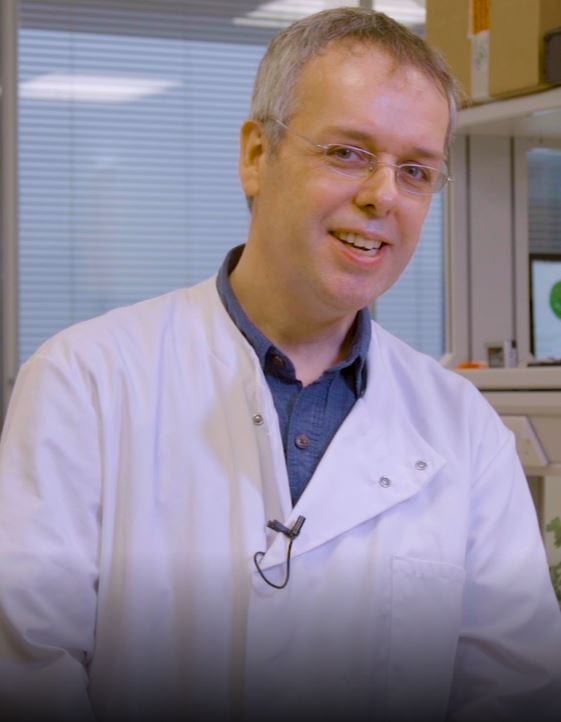Dr Tom Ashfield heads up CHAP’s Phenotyping Lab at Rothamsted Research. His work is focused on using digital imaging to ease high-throughput phenotyping of crop responses to biotic threats. He is interested in understanding the evolution and function of disease resistance genes in plants. We caught up with him to find out about his work and influences, and what it’s like to lead one of CHAP’s flagship capabilities.
How do you generally introduce yourself and the work you do?
I oversee the science in the CHAP Phenotyping Lab based at Rothamsted. The facility uses advanced imaging equipment (different types of high performance specialist cameras) to automate the detection and quantification of plant traits and responses, visible and invisible to the naked eye, with a particular focus on those connected to biotic threats: pathogens, pests and weeds. This type of automation has important applications in many areas of agricultural science, whether it be assessing how effective new products are in enhancing plant growth or controlling weeds, or for the precision application of treatments in the field to reduce the environmental impact and production costs.
You specialise in phenotyping, what is that exactly and how did you end up choosing this field of interest?
Phenotyping simply refers to scoring plant traits or attributes – that is observable characteristics – whether they be something morphological such as plant size or leaf hairs, or more subtle, like disease resistance.
What we do in the phenotyping lab is to try to make this more efficient by using imaging to automate the scoring of traits rather than simply score them manually using the naked eye. This is an important factor because in activities such as plant breeding, phenotyping can often be the rate-limiting step.
Having spent many years investigating various aspects of how plants defend themselves from disease, it was an exciting prospect to investigate how cutting-edge technology could be exploited to help develop new control methods and to monitor disease and other traits in the field, glasshouse or in vertical farming.
What did you do before heading up the CHAP Digital Phenotyping Capability at Rothamsted?
Previously I was based at Indiana University in the United States where my research focused on understanding disease resistance in plants, with most of my work involving soybeans and pathogenic bacteria and viruses. I used diverse approaches ranging from classical genetic studies, cloning of plant genes conferring resistance to pathogens, and working with colleagues to explore the possibility of engineering novel resistance traits.
Did you have a mentor/someone who had a big influence on your own decision to specialise in this field? Who were they and how did they influence your career path?
Not specifically for my move into plant phenotyping, but mentors have certainly played key roles throughout my career. I’d highlight three people in particular: my PhD and post-doctorial advisors Jonathan Jones based at the Sainsbury Laboratory in Norwich and Roger Innes at Indiana University, and finally Kim Hammond-Kosack here at Rothamsted, for her mentoring in my current role. They have all provided excellent guidance at various points in my career while also giving me the opportunity to develop my own ideas and independence.
What do you enjoy/appreciate most about your job?
Perhaps the thing I appreciate most is the opportunity to work with both scientists in an academic institute and individuals working in many applied roles in agriculture, technology, and business. Everyone brings their own unique skills and outlooks, which creates an exciting atmosphere to work together. I also have a great team of colleagues working with me in the Phenotyping Lab that I’m hugely appreciative of!
And what do you find most challenging?
Because we work with a diverse range of stakeholders, ensuring everyone’s interests and expectations are addressed is a key factor. For example, while a key aspect of our activities is to form partnerships with companies to help them develop practical solutions to apply in the field, we also need to respect the legitimate interest of the academic researchers we work with to keep publicly funded research available to all.
Furthermore, on a purely technical front, the diverse range of work we undertake means that most projects will present new challenges that need to be overcome with respect to image capture or analysis.
How has the work you do been affected by/benefited from the partnership between CHAP and Rothamsted?
The facility was established as a partnership between Rothamsted and CHAP and both parties continue to play key roles in ensuring its success. CHAP contributes in numerous ways, ranging from helping to identify key areas where imaging could be applied in agriculture, assembling project consortia, project management and working with others to explore funding opportunities. The partnership with, and physical location at, Rothamsted Research ensures access to superb facilities such as glasshouses and controlled environment chambers. Furthermore, being based at Rothamsted provides the potential for partnerships with the Institute’s scientists and so to benefit from the amazing depth of crop-related expertise located on the research campus.
What is your biggest achievement to date – personal or professional?
It’s hard to pick one specific event, but key achievements have included being one of the first people to use map-based cloning to isolate a soybean gene, working with colleagues to demonstrate the potential for developing novel disease resistance traits by using genetic engineering to alter pre-existing resistance, and the role I’ve played in establishing the CHAP phenotyping lab!
One key achievement since joining the phenotyping lab has been to work with Fotenix, an SME, to assess the capabilities of an advanced multispectral imaging system they have developed. Another has been to work with the Small Robot Company to assess the feasibility of developing an autonomous slug monitoring and treatment system.
What advice would you give to recent new entrants to your area of specialism – is there something you wish you had known before you took a particular direction?
My advice would be the same as for entering any other area of specialisation: follow the path that really excites you, keep learning, and try to keep focus on some career goals. If you are interested in phenotyping, or especially in the remote sensing of plant traits, there is really exciting work to be done in the general area of computer vision and associated artificial intelligence (AI) fields, so developing expertise in those areas would be valuable.
What do you do when you aren’t working? What might your work colleagues be surprised to know about you?
I enjoy all things nature-related and love being outside whenever possible, whether going for a hike or getting out on my bike when I get the chance. Perhaps surprisingly, I’ve previously been a keen beekeeper!
To see Tom in action and find out more about the Phenotyping Laboratory, click onto the following link to enjoy a CHAP webinar entitled Focus on digital plant imaging at CHAP’s Phenotyping Laboratory.
To read about the collaboration between CHAP’s Phenotyping Lab and Fotenix that Tom mentions go to Projects, or to read about the project with Small Robot Company, go to SlugBot.
If you have any questions about CHAP, our Membership Scheme, or are interested in working with us on a specific project, then please send us an email at enquiries@chap-solutions.co.uk
Please note, the opinions expressed in this article are the author’s own and do not necessarily reflect the views or opinions of CHAP.












